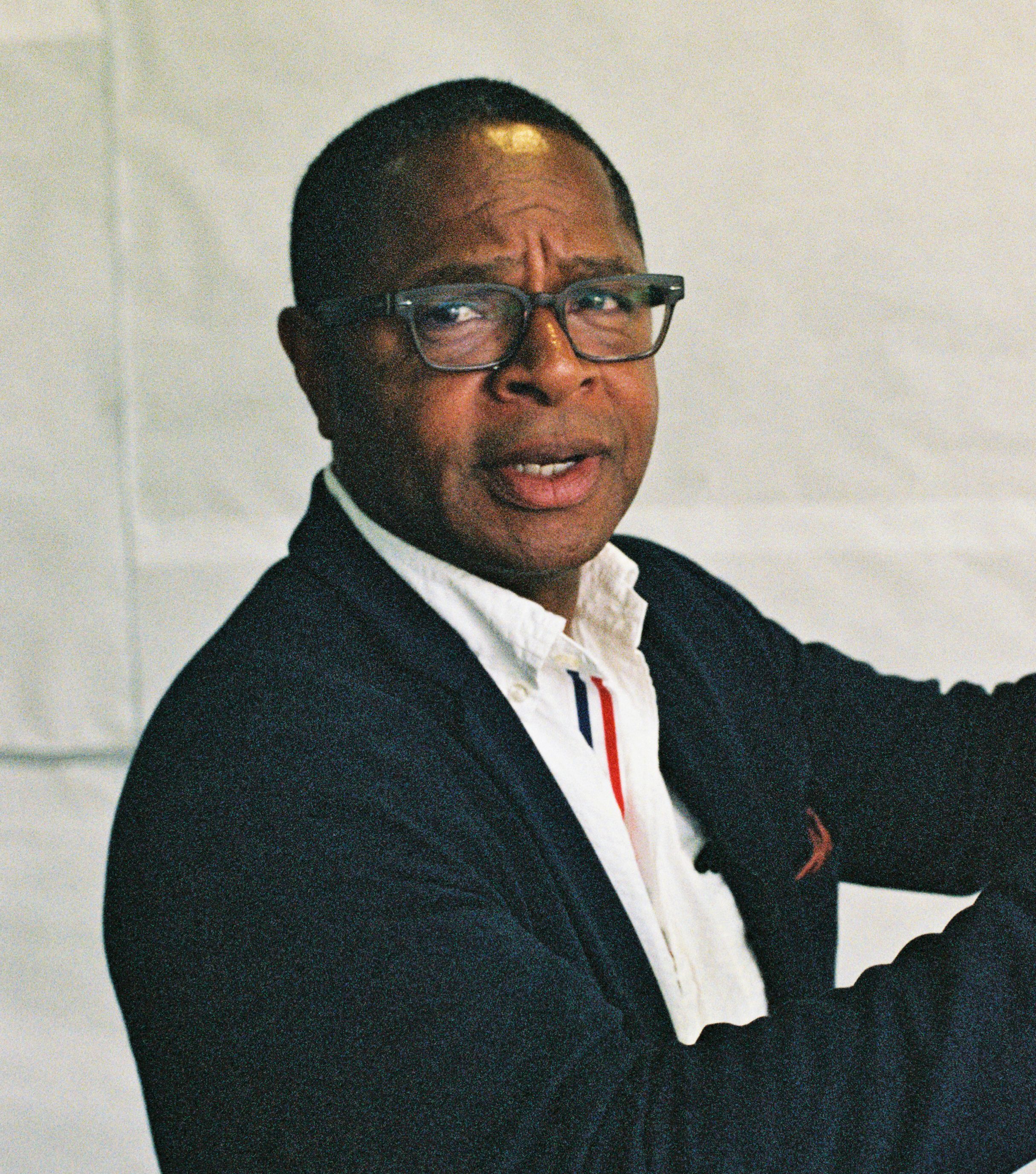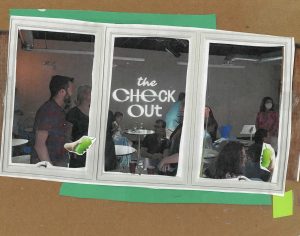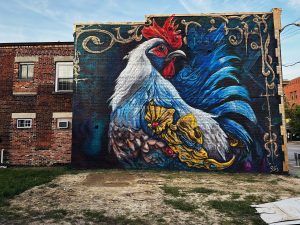I met Rufus Williams at “Powerful Platforms: A Community’s Call to Action,” a BBF Family Services Open House event back in June, designed to bring community awareness to Envisioning Justice and BBF’s role as one of seven Envisioning Justice hubs throughout the city. Established in 1961 as a boxing gym for boys in the neighborhood, BBF (the initials reflect its former name, Better Boys Foundation) now provides resources for children and adults in North Lawndale, an area of Chicago historically vulnerable to political and social disenfranchisement. Current BBF programs address the broad developmental, educational, and employment needs of members of the community, including those reentering society from jail or prison.
Williams is President and Chief Executive Officer of BBF Family Services. BBF is housed in a modern two-story building at 15th and Pulaski, luminous on the interior, with floor-to-ceiling windows on both floors that look onto an uncovered center courtyard. At the Open House there were arts and crafts for youngsters, and a community resource room where various local groups had set up tables, providing information about their services. I chatted for a while with Onye Davenport, a formerly incarcerated Outreach Worker for Target Area, and picked up a few copies of a glossy comic entitled, “Your Guide to the Juvenile Justice System,” to take back to UCAN, another social service agency in North Lawndale, where I work full-time with adolescents, many of whom have come in contact with the law.
Lunch was served, and after performances of music and poetry by BBF teaching artists and students, Williams moderated an interactive discussion on police-community relations with Maurice Classen, Director of Strategy for the Chicago Police Department; Maira Khwaja, Engagement Director for Invisible Institute, a journalism production company on the South Side; and Kenny Smith, a North Lawndale community leader who this year became the first criminal offender to complete programming under the aegis of the year-old Restorative Justice Community Court (held weekly on UCAN’s campus). Williams and the panelists sat in a circle of chairs with about 40 members of the community as the mic was passed around. Folks had lots of questions for Classen, who was earnest in his attempt to humanize conspicuous police activity in North Lawndale. Khwaja and Smith, each in their own way, represented a collective wariness of law enforcement among those present.
Recently, I spoke with Williams in his office at BBF about takeaways from the BBF Open House discussion and programming at BBF designed to tackle the problem of incarceration. Williams’s statements from our conversation have been condensed for clarity and length.
Eric K. Roberts: What was the impetus for the discussion on police-community relations? The police are already pretty active on the West Side. What’s not working?
Rufus Williams: When we talked about this project for very first time, I just went off the notion of envisioning justice: What does justice look like? What justice looks like to people in Lawndale, in Garfield Park, in Austin, may be very different to what justice looks like to people who live in Lincoln Park, or the Gold Coast, or in Hyde Park. How do we make it make sense to everybody?
We have periods of unrest, of what seems to be extreme violence. The answer to much of that from the authorities is to add more police – “We need more police.” The mayor came to Lawndale and talked about adding a 1,000 new police to the force. I listened to that – being one who grew up Lawndale, works in Lawndale, and lives in Lincoln Park – are the additional police for the people of Lawndale? Or are the additional police to police the people of Lawndale to make everybody else feel safe in other places? I think it’s the latter. The numbers that I’ve heard said there was something like 885 police officers in Lawndale, for less than 36,000 people. That’s about a police officer for every 40 people. That seems like a lot. We still have to wonder why the clearance rate on murders and shootings is so unbelievably low if you’ve got this many police officers who are policing. The clearance rate for murders is 15.6%. People are asking why. I haven’t heard a good answer yet.
You drive down Roosevelt Road and you’ll see police SUVs just sitting with the lights on. That feels like an occupying force. That feels like you are here intrusively. And I don’t know if people necessarily feel safer because of that. Because there are still, as I’m told, things that happen not very far away from where those police cars are. The discussion about community policing – what does that mean to the community? What does that mean to the mayor? What does that mean to the police chief? What does it mean? I’ve heard the conversation about places where crime has been reduced. Take Englewood, for example – it was because they had the ShotSpotter and they had police who were walking the beat. Walking – I do think that if there were more policemen on the ground, not in cars, then you may build those relationships. If community policing means we’ve got more policemen who are out of cars, on the street, walking the beat, connecting with people before things happen – people know who to call, what to do, they know who people are – that has some legs. I haven’t seen a lot of that here. It’s hard to build the relationship out of the car.
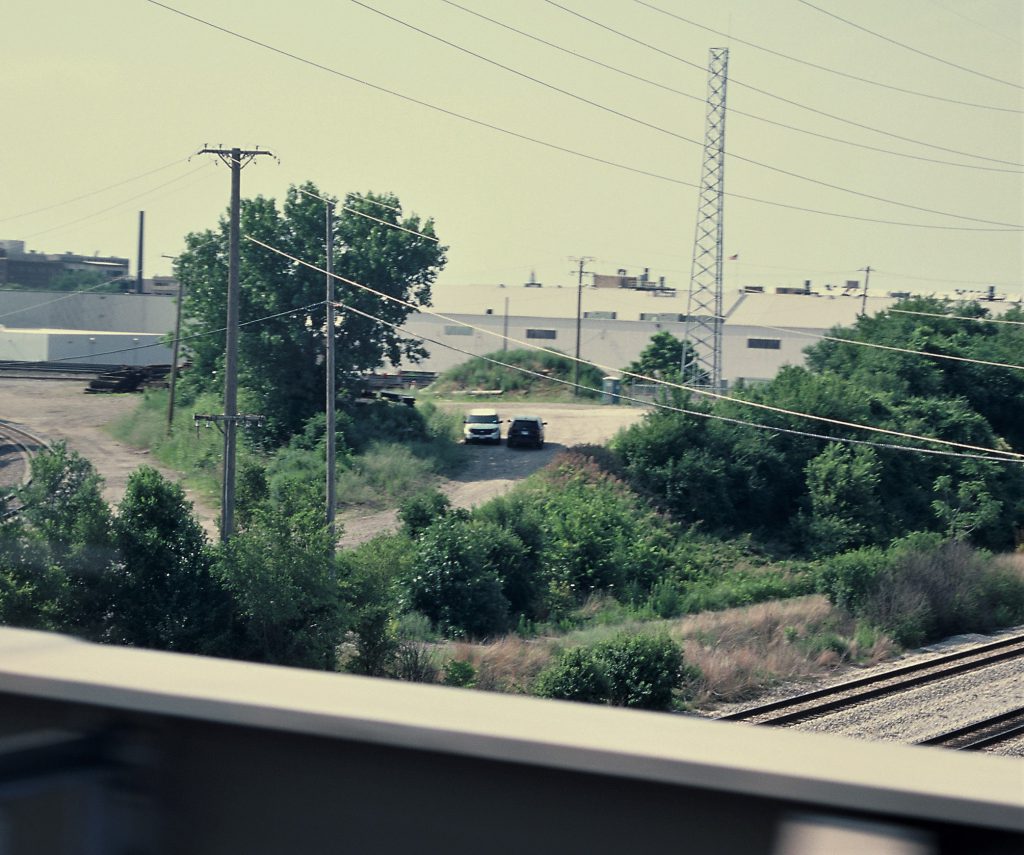
A lot of things may need to be rethought. Policing may need to be rethought. How we deploy assets needs to be rethought. Recognizing that the vehicles work against relationships, personal relationships. In his first mayoral run, [Rahm Emanuel] talked about how we need more beat cops. Beat cops by definition, I think, are people out walking the beat. Why we haven’t seen it, I don’t know. But we don’t see it.
EKR: There were a number of people in the room who voiced skepticism about the possibility of better police-community relations [Khwaja, Smith, et al]. Do you think there’s a comparable level of skepticism on the part of outsiders when it comes to reducing violent crime in North Lawndale?
RW: It troubles me when I hear people in powerful places who effectively throw their hands up, saying, “We really don’t know. We really don’t have an answer to this.” I think there are answers. I think the answers they come up with are short-term answers. So you look later and you still have the same problem. A short-term answer is putting more policemen on the street. A short-term answer is to have gun buybacks. The longer-term answer is: yes, you need this presence, but you also need to look at what the root causes are that create this unrest.
The root cause to a lot of our violence issues is poverty. We don’t have the same kinds of shootings and such in Lincoln Park. We also don’t have abject generational poverty in Lincoln Park. When people have mental issues, people have resources to deal with that. That’s not what happens here. When you have trouble paying the rent, getting food, you have a lot less patience. That [lack of] patience shows out in a lot of different ways, but those ways manifest themselves, and teach the next generation and the next generation that this is how you deal with conflict and problems. And so to the extent that there are answers to these issues, it takes real thinking about it, and it takes moving away from a political cycle, and saying, “What do we really need to do? How do we really fix this?” And there have been conversations, but they’ve never really never led to what the answer is.
EKR: I hear a lot of folks ready to give up on the whole idea of police in the first place, who envision a world without police. Is clarifying the basic idea about the purpose of law enforcement necessary for improving police-community relations?
RW: There are basic contracts that we have. I believe you’re gonna drive on the proper side of the street so I can drive on the proper side of the street. If you decide to drive on the wrong side of the street, somebody’s gotta make sure that we all honor this general contract that we have. The police help to do that. We do have laws, and they have to be enforced. Let’s enforce them, let’s do them fairly, and let’s do them with some level of compassion.
I got pulled over one day in Lawndale because I didn’t stop for a woman in the crosswalk, allegedly. I get a ticket; I’m upset; I go to traffic court to fight it. And, it was very interesting to me that at traffic court, downtown, if there were 50 people in the court, 45 were black. How can this be? I mean, this is not court in Lawndale, this is downtown. I watch people go up, and the judge is asking, “Can’t you pay something? Five dollars? Ten dollars?” “No, your honor, I can’t pay anything, I don’t have a job, I can’t pay anything.”
When you’ve got this heavier policing for these kinds of things, it helps to magnify poverty. Police are necessary to ensure that we all follow the general contracts that we sign on to just by participating in a society, but some of the things that are done are just – they’re unfair. And it’s overburdening it some places where it doesn’t need to be. I got a red-light camera ticket in Lincoln Park, and that camera isn’t there anymore. But you drive down Pulaski Road, from here up to Fullerton, I think you pass four red-light cameras. So some of those burdens are just heavier in certain places, and there’s not a graduated rate – you’re not getting a lower ticket just because you live in Lawndale. That ticket is the same as it is for somebody who lives in the Gold Coast, who tips $100, and this $100 makes a difference on whether my family eats.
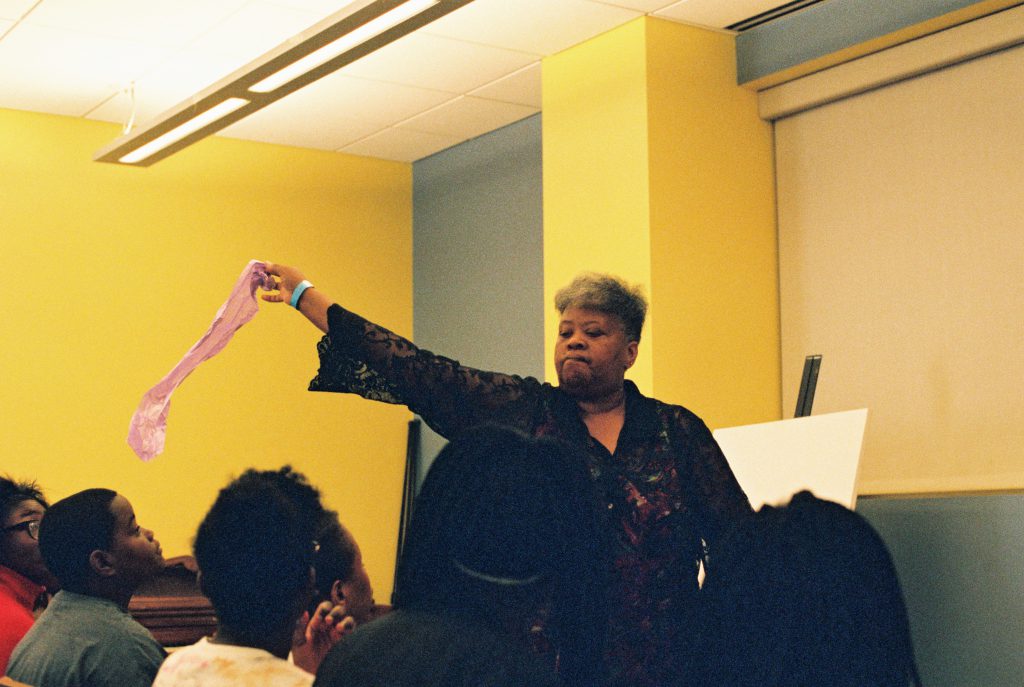
EKR: Maurice Classen, the Director of Strategy for the Chicago Police Department, is a lawyer, but I didn’t see any police officers at the Open House. Can you talk about BBF’s direct relationship with the police?
RW: We’re doing work as best as we can to help bridge the gap between the community and the police, because we have to have police and we have to figure out how to make this work, we have to figure out how not to get shot in the process.
We have our police baseball league, where we try and connect the police with our 9-12 year-olds by coaching baseball, and the community comes out and everybody sees people…as people. Baseball has been a dying sport in our community. We can revive it in this way. Children are interested, and willing to pay attention and learn. Parents are much more involved with their children at those ages. So trying to get the community to come out and support them – we’re more likely to do it with the younger children than with the teenagers. And they’re much more malleable kids at those ages. It is not a thing that will change everybody’s perception of the police, or the police’s perception of everybody. We recognize that. We gotta start, we gotta get in, we gotta do something. So the [baseball] program that we have here is funded by Get IN Chicago. It started in Englewood, the next year we [started], then the following year Austin picked it up. We had an All-star Game down at Curtis Granderson Field at UIC with all three leagues together. Baseball, police as coaches, community engaged.
We invited the police over here when they were looking to hire more diversity in the police department: “Come to BBF, set up your computers here, we got big posters in the window. Come over here and start signing up applicants. We want to make this better.”
We did a march from here to [where] Dr. King lived when he lived in North Lawndale, at 16th and Hamlin, on April 4th, the 50th anniversary of his assassination. Our kids put up signs that said: “Rest in Peace, MLK,” “I am a man,” as they did in Memphis at the time, and we had police escorting us, stopping traffic and all. I called the police department that day and I said, “I just want you all to know what we’re doing,” I wasn’t asking for escorts, and they sent over cars. They said they’d send over one, they ended up sending over three. It was interesting, though, walking down the street with a little kid, who said, “Why are the police following us?” So, it’s gonna take effort, and a lot of the effort has to come from the police, but it’s gonna take effort, and thoughtfulness, and work. I’m hopeful because I don’t how else we can be given that we still have a lot of children here. I have children and grandchildren, and we’ve gotta figure out a way to make it work.
EKR: My supervisor [at UCAN] related a story to me recently where, after a particularly violent weekend in North Lawndale, an elder had expressed forlornness about the youth: “The kids don’t care anymore.” How do we overcome a self-defeating attitude toward the problem of violence?
RW: I am not gonna say I’m an eternal optimist, but I’m hopeful. And hopeful with reason and with cause. When anybody says, “Our kids are out of control,” let’s stop and look at the age of the kids that are “out of control.” Are they 19? are they 16? are they 14? If they’re 14, that kid was 10 years old four years ago. I have to believe that everybody believes that they can help to teach a 10-year-old child right from wrong and what to do. If we can make sure all of our 10-year-old children are doing and learning and operating in that space, then we don’t have this problem four years, six years later.
Any time we think our kids are out of control, there’s something else that’s gone astray. Some of this is individual decision, but some of this is truly systemic. We have the issue of mass incarceration, which breaks up families, breaks up households. Sentences are long, cash bails are difficult. And so you end up with this broken family; you end up with broken children. And so the children being out of control is simply because all the mechanisms that would teach them are broken.
We find here at BBF – the work that we do with children in our mentoring program, in our after school programs, and wherever we can connect with them – we learn that we can help to alter behavior. We know that their behavior is altered when we’re with them. Then they’re released back to the war zone, back to the same place that they came from, and they repeat the kind of things that they were doing before. So, to the extent that we can keep them, hold them, and get them to a different environment somewhere along the way, then we really have a chance. But it’s just difficult right now because we know that those who are in some of the more difficult, more dangerous situations – we just see ’em, they’ll come in my office, we’ll sit, we’ll talk, we’ll do whatever, they’ll do the same thing with their mentors and people around the building. The weekend will come, Monday will come, and we’ll hear that something happened. Well, how did that happen? It’s the environment that they’re in, it’s the war zone they get released to.
Any time anyone tells me that this is hopeless – do you think a 10-year-old kid is hopeless? If you don’t believe that, then you have to believe this is not hopeless. Education is really important. If we can get the education right, then we can solve a lot of our other problems. Seventy-one percent of the schools in North Lawndale have gone through some kind of action. They’ve been closed, they’ve been turned around, they’ve been turned to charters. Often that action was happening because it was determined the schools were not performing as well as they should. It’s really not schools that don’t perform – it’s the students that aren’t performing. You aren’t seeing the results from the students, for whatever reasons. I still think there has to be a tighter evaluation of the why. Why aren’t they performing? What is the real reason?
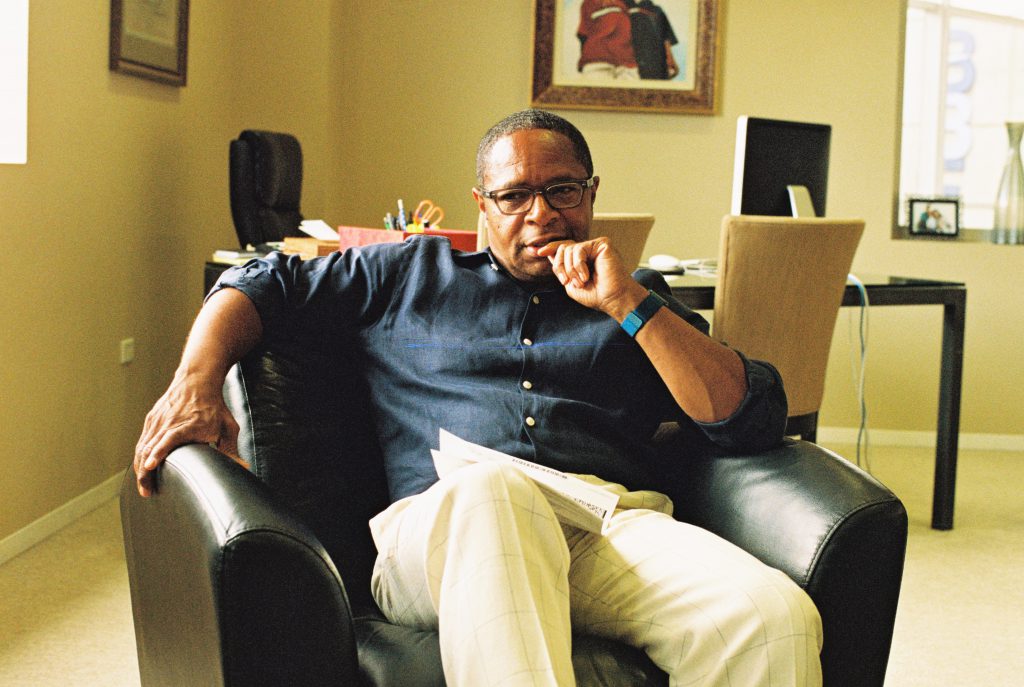
I grew up in Lawndale. We didn’t grow up with a lot of means, but we did grow up knowing that education was important. And when I got out of high school, I didn’t have the money to go to college, I couldn’t get a job at any place other than Burger King, making $1.90 an hour. Through BBF I was able to get a scholarship. I got on to college, and I graduated, and I went on to work at Arthur Andersen, and began my professional life. So I recognize clearly the benefit of education for providing that bridge from poverty to a different life than one might be able to have. If I talk to a child, one of the first questions is about school, because I think we can determine from their attendance and from their achievement, what they’re really doing. They may say they need a job, “I need money for all this” – that’s an adult issue. Children should be children, they should be in school. They should be focused on that, because that is what is going to get them their next leg up. So when I got here, we hired an Education Manager, because that’s important: trying to ensure that we got children who are in school, that we’re getting reports on children that are in school, that we have relationships to help advocate for the children who are there; to work and see if there are ways in which we can help find money for them to move on to college after they finish high school; to try and give them some exposure, give them trips, give them things that help to show them something different from what they see all the time.
EKR: At the Open House, I spoke with an Outreach Worker for Target Area, which helps with reentry services on the South Side. I understand BBF provides reentry services as well.
RW: Yes. I mentioned mass incarceration. North Lawndale and Austin are the two communities that have more people reentering than any other communities in the country. There are services that are needed for people that are trying to reenter society. Unless we can rebuild these communities in ways in which people can really thrive and not be back in same situation as they were in before, recidivism becomes that much higher. We have a man on staff who went to jail, for 14 years, for a crime he didn’t commit. He runs our reentry program. He deals with people who’ve been incarcerated. The spirit is amazing – I don’t know that I wouldn’t be angry; he’s not. But he’s aware of what they need and he works with people and tries to help get them some of the basic things that people need. [Cook County Sheriff] Tom Dart talks about the fact that our jails, Cook County jails, [comprise] the largest mental institution in the country. Are we serving them well? Are we serving them well when they’re in? Are we serving them well when they’re out?
The work that’s happening with the Restorative Justice Community Court is trying to keep people from going [to jail], trying to change the paradigm. What are options for people who commit crimes? How do we build empathy? How do we make sure you understand that you harmed somebody? This is the person that you harmed. Let’s all come together and talk about it. How do you repair the harm that you did, and make it better so that it doesn’t happen again? We have to break that cycle, because the jails have gotten too full.
Most of our work is done with people between the ages of 5 to 23. From working with young people we get a better sense of what’s happening in their family, then we can help to provide more resources to the family. A lot of our families need counseling. A lot of our children need it, because we know they’ve experienced some trauma, trauma that hasn’t been dealt with. You talk to a child whose friend just got killed on the street, and they haven’t talked to anybody. So we’re trying to cover a lot of bases. We’re trying to, one, prevent [incarceration], we’re trying to work with police to do some things, and for those who are in, we’re trying to help them as they come out, to rebuild families and rebuild the community.
EKR: Obviously the problem of police-community relations is a thorny one. What else can be done?
RW: One of the things I’m pressing whenever I have the chance is: getting people registered and voting. So many decisions get made by the people who we either vote in or don’t vote in. We’ve gotta participate in the process. You have to understand the process, you have to be thoughtful enough to ask the right questions in the process and fully participate. So education becomes so important for so many reasons, and we’re really working hard to try and elevate that here. The work that’s being done with Envisioning Justice helps in that same vein, helps you to understand what these things are. How do you change? If you don’t like this, how do you change it? We just have to make sure that people are educated enough to understand it.
I want people to engage. In the last gubernatorial primary, the turnout was 17%. I just need you to be in! Right now I just need people to vote! I need people here to vote, because then I can go to an alderman, a mayor, or a governor and we can ask for things. We have to show our power.
This article is published as part of Envisioning Justice, a 19-month initiative presented by Illinois Humanities that looks into how Chicagoans and Chicago artists respond to the impact of incarceration in local communities and how the arts and humanities are used to devise strategies for lessening this impact.
Featured Image: A portrait of Rufus Williams, President and Chief Executive Officer of BBF Family Services. Williams is wearing a blue blazer and glasses against a white backdrop, gesturing to his left while looking at the camera, his hands outside the frame. Photo by Eric K. Roberts.
 Eric K. Roberts is a social worker, actor, and photographer based on the West Side of Chicago.
Eric K. Roberts is a social worker, actor, and photographer based on the West Side of Chicago.